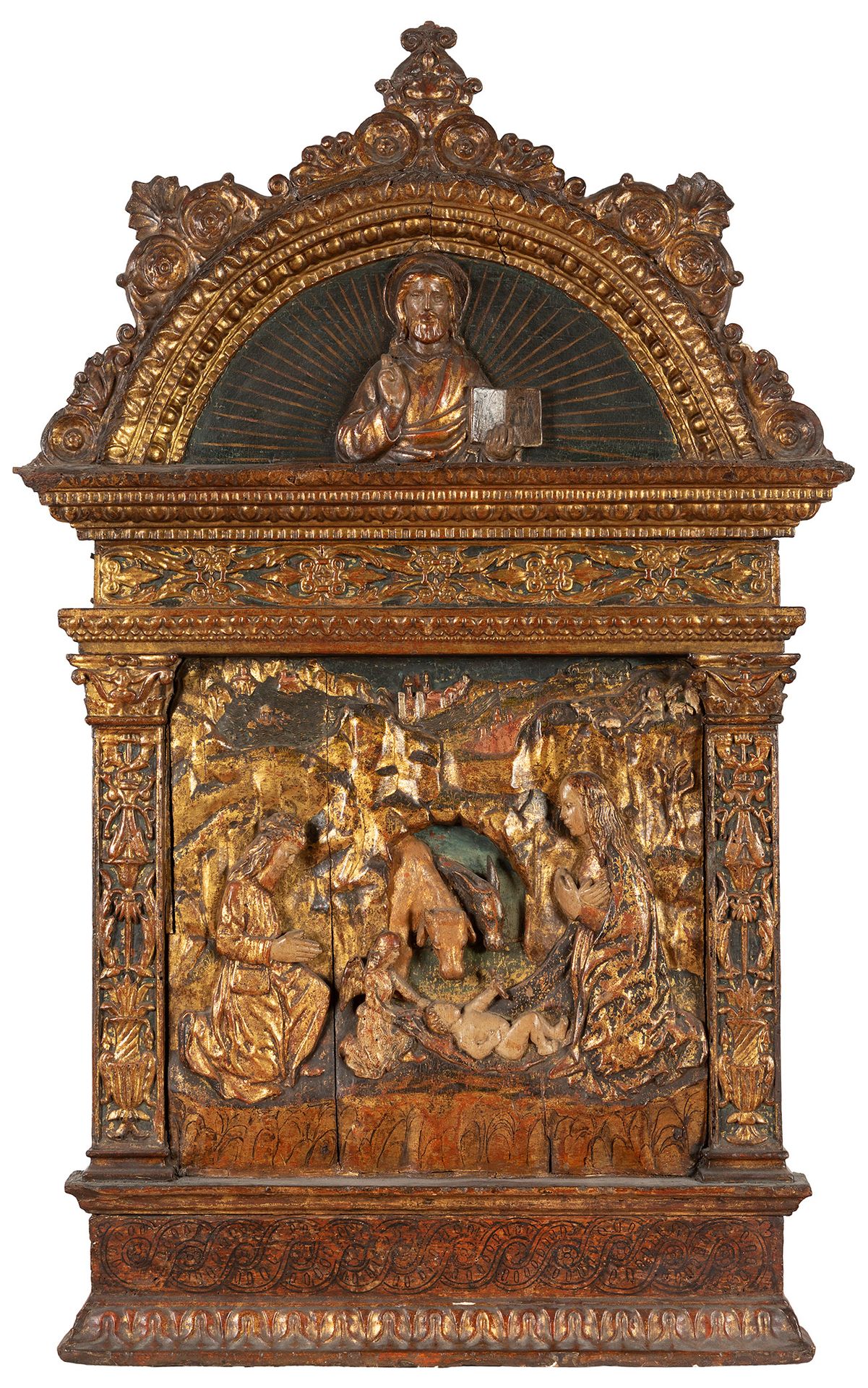Description
Altarpiece. Renaissance. Italy, first half of the 16th century. "Nativity". Carved, polychromed and gilded wood. Polychrome back. Good state of conservation, except for two frontal cracks. Measurements: 115 x 74 x 12 cm. Renaissance altarpiece in carved, polychromed and gilded wood. The back part also showed a scene, as can be seen by the remains of the polychromy. Renaissance artists of a certain prestige were commissioned to make an altarpiece at some point in their lives, whether it was an altarpiece or a chapel altarpiece. Here we have an altarpiece of architectural form, with the Nativity theme presiding over the front. Two pilasters frame the scene and the structure is crowned, above the entablature, by a circular tympanum that contains the figure of Christ blessing, mayestàtic, an iconography inherited from the medieval period. The Manger scene combines bas-relief and high-relief in order to represent different levels of depth that place the figures of Joseph and Mary, as well as the archangel Gabriel, around the newborn baby. An ox and a donkey poke their heads out of the stable. The town of Bethlehem and the mountainous terrain have also been carved with painstaking attention to detail, echoing Renaissance concerns for giving depth and atmosphere to the space. The carving is of high quality, as can be seen in the finish of the female figure, the Virgin, with her soft features and turned hands. Except for the flesh tones and some details of the landscape, the rest of the scene features gilded wood, as well as the vegetal work on the pilasters and the coping. The ornamentation is also characteristic of the Renaissance period, freely combining elements of Greco-Roman origin. Rockery motifs and foliated fretwork complete the decoration. Designed to be placed behind or above the altars of churches, altarpieces could consist of painted panels, sculptures or both. They were intended to astound the congregation with striking images from biblical history. Those consisting of folding panels were kept closed for most of the year and were only fully revealed on special occasions such as Easter and Christmas.
88
Altarpiece. Renaissance. Italy, first half of the 16th century. "Nativity". Carved, polychromed and gilded wood. Polychrome back. Good state of conservation, except for two frontal cracks. Measurements: 115 x 74 x 12 cm. Renaissance altarpiece in carved, polychromed and gilded wood. The back part also showed a scene, as can be seen by the remains of the polychromy. Renaissance artists of a certain prestige were commissioned to make an altarpiece at some point in their lives, whether it was an altarpiece or a chapel altarpiece. Here we have an altarpiece of architectural form, with the Nativity theme presiding over the front. Two pilasters frame the scene and the structure is crowned, above the entablature, by a circular tympanum that contains the figure of Christ blessing, mayestàtic, an iconography inherited from the medieval period. The Manger scene combines bas-relief and high-relief in order to represent different levels of depth that place the figures of Joseph and Mary, as well as the archangel Gabriel, around the newborn baby. An ox and a donkey poke their heads out of the stable. The town of Bethlehem and the mountainous terrain have also been carved with painstaking attention to detail, echoing Renaissance concerns for giving depth and atmosphere to the space. The carving is of high quality, as can be seen in the finish of the female figure, the Virgin, with her soft features and turned hands. Except for the flesh tones and some details of the landscape, the rest of the scene features gilded wood, as well as the vegetal work on the pilasters and the coping. The ornamentation is also characteristic of the Renaissance period, freely combining elements of Greco-Roman origin. Rockery motifs and foliated fretwork complete the decoration. Designed to be placed behind or above the altars of churches, altarpieces could consist of painted panels, sculptures or both. They were intended to astound the congregation with striking images from biblical history. Those consisting of folding panels were kept closed for most of the year and were only fully revealed on special occasions such as Easter and Christmas.
